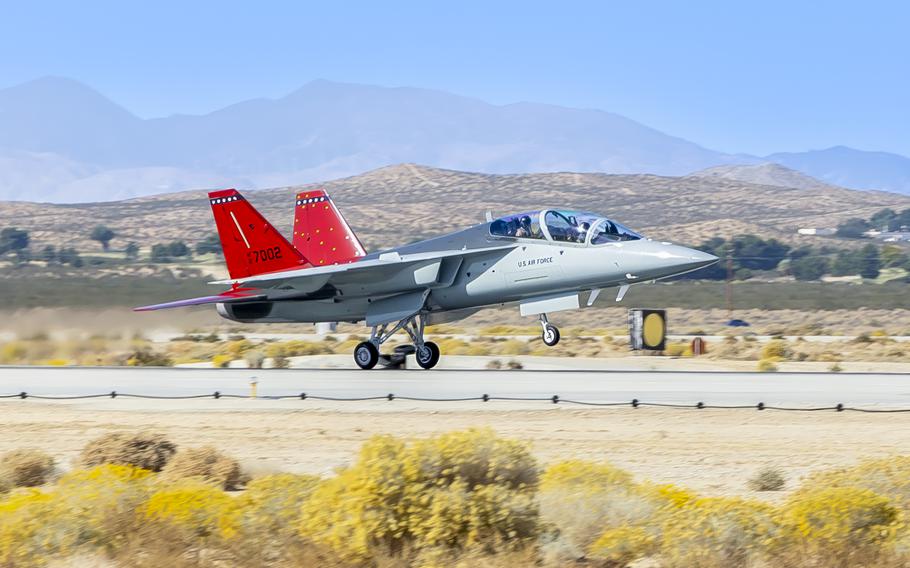
The first T-7A Red Hawk arrives at Edwards Air Force Base, Calif., Wednesday, Nov. 8, 2023. (Todd Schannuth/U.S. Air Force)
Edwards Air Force Base in California has received its first T-7A Red Hawk, an advanced training jet that will begin final testing and eventually replace the older planes that have helped mold American pilots for more than 60 years, the service said Thursday.
The first Red Hawk arrived at the base, located about 60 miles north of Los Angeles, after a 1,400-mile, cross-country flight that included stops in Oklahoma, New Mexico and Arizona.
In development since at least 2016, the T-7A is a collaboration by Boeing and Saab that has built-in flexibility to evolve in the future as technologies, missions and training needs change. The plane will eventually replace the T-38 Talon, a training aircraft with 1950s technology that’s been training American pilots since 1961.
“This arrival marks an exciting transition into the next phase of developmental flight,” said Air Force Maj. Jonathan Aronoff, a test pilot. “The T-7A gives immense capability updates that will allow the Air Force to train the next generation of combat aviators. Success of first delivery is truly a testament to the joint USAF-industry team we have in place.”
The Air Force has been plagued by several T-38 crashes in recent years. A year ago, an in-flight emergency forced one pilot to eject from a T-38 over Columbus Air Force Base, Miss., and two aviators were killed in 2019 — an instructor and a student — when their aircraft crashed on landing at an Oklahoma base. There were also several T-38 crashes in 2017 and 2018, including one that killed a pilot at Laughlin Air Force Base in Texas.
“The T-7A is a brand-new, state-of-the-art pilot training system created specifically for the Air Force, with the purpose of training future fighter and bomber pilots,” the Air Force said. “The aircraft is the first digitally designed tactical aircraft, finessed using model-based systems engineering and 3D design tools.”
Boeing calls the T-7A Red Hawk a “low-risk, leading-edge, live, virtual and constructive fifth-generation aircrew training system that delivers a multi-generational leap in capability to revolutionize and reinvigorate fighter pilot training.” The jet can carry two pilots and is powered by a single General Electric F404 turbofan afterburning engine.
Officials said the milestone at Edwards AFB marked the beginning of the jet’s developmental flight test period, which will involve teams from the Air Force and Boeing working together to certify the aircraft.
“Test pilots have been busy rehearsing missions in the simulator and will quickly begin to fly up to three times daily,” the service said. “The [testing teams] will utilize a mix of both Air Force and contractor-owned aircraft to swiftly bring cutting edge capability to train the next generation of warfighters.”
The origins of the T-7A Red Hawk go back about 20 years when the Air Force’s Air Education and Training Command began looking for a successor for the T-38.
The service considered proposals from several aerospace companies — including Lockheed Martin and Northrop Grumman — but ultimately chose the single-engine, twin-tail aircraft initially known as the “T-X.” At first, the Air Force hoped to put the T-7A Red Hawk into service in about 2020, but the timing was pushed back by various delays and budget issues. An Air Force pilot flew the plane for the first time at a Boeing facility in St. Louis in June.
“To the next generation of aviators, I can safely say I am jealous,” Maj. Bryce Turner, another test pilot, said at the time. “This aircraft’s performance, commitment to pilot safety and ground-based training system is something I could only dream of during my time in flight training.”
The name “Red Hawk” is a tribute to the Tuskegee Airmen, the historic group of pilots who during World War II became the first Black American military aviators. They were also known as the “Red Tails,” due to the color of the tail sections on their planes. The tails on the T-7A Red Hawk are also red.